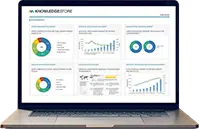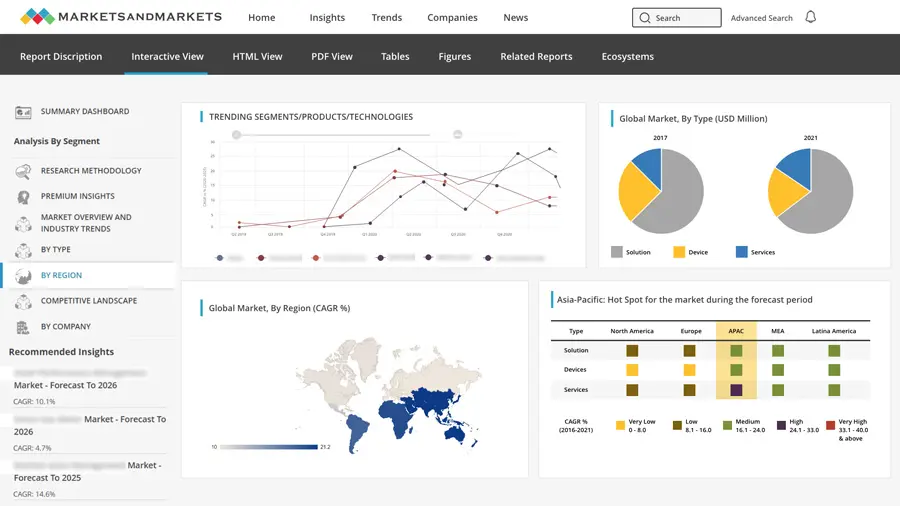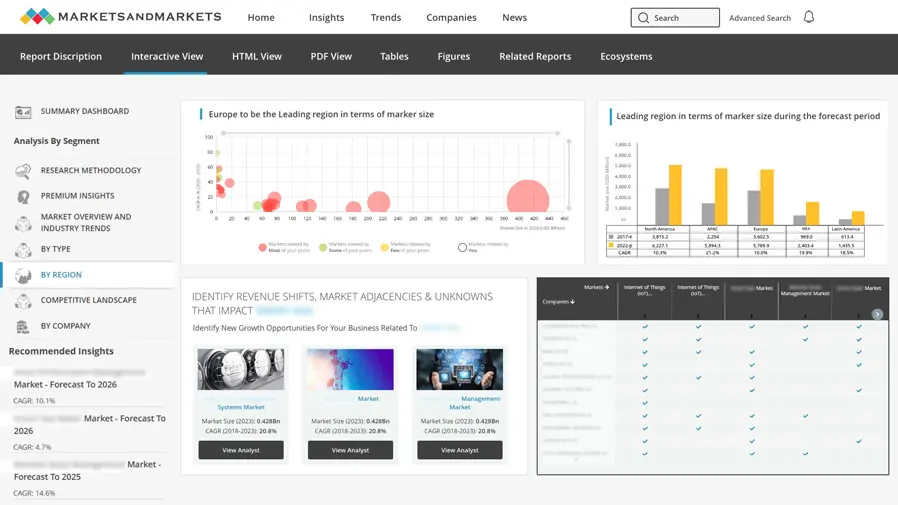Vacuum Pump Market By Type (Rotary, Reciprocating, Kinetic, Dynamic, Specialized), By Lubrication (Dry, Wet), By Vacuum Level (Low (1000 To 1 Mbar), Medium (1 To 10-3 Mbar), High (Above 10-3 Mbar)), By End-User (Electronics, Chemicals & Petrochemicals, Food & Beverages, Pharmaceuticals, Plastics, Metallurgy, Wood Processing, Solar, Others), By Region (North America, Europe, Asia-Pacific, Middle East & Africa, South America) - Global Forecast to 2030
The Vacuum Pump market is anticipated to grow from USD 6.5 billion in 2025 to USD 8.4 billion by 2030, with a CAGR of 5.3% during the forecast period. A vacuum pump is a mechanical device designed to create a partial vacuum by removing gas molecules from a sealed space. This process reduces the pressure within the chamber below atmospheric levels, enabling applications requiring controlled low-pressure environments. Vacuum pumps operate based on principles of pressure equilibrium, where gases naturally flow from areas of higher pressure to lower pressure zones. They are utilized in various industries, including chemicals & petrochemicals, pharmaceuticals, food & beverages among others.
The global vacuum pump market is experiencing steady growth, driven by increasing demand across key industries such as semiconductors & electronics, pharmaceuticals, and chemicals & petrochemicals. As technology advances, the need for high-precision manufacturing and contamination-free environments in electronics and healthcare sectors is boosting the adoption of vacuum pumps. Additionally, the rise in energy-efficient systems and strict environmental regulations are pushing manufacturers to develop more sustainable and high-performance pumps.
Vacuum Pump market includes five types: namely rotary, reciprocating, kinetic, dynamic, and specialized. Rotary vacuum pumps are widely used due to their compact design, energy efficiency, and ability to maintain consistent performance in a variety of industrial settings. They are predominantly used in chemicals, pharmaceuticals, and food & beverages, where a steady vacuum is critical. Their growth is supported by increasing automation in manufacturing and a rising demand for precision in production processes.
The end user segment of the Vacuum Pump market is further segmented into semiconductor & electronics, chemical & petrochemicals, pharmaceuticals, food & beverages, oil & gas, pulp & paper among others. In Semiconductor & electronics industry vacuum pumps are essential for manufacturing processes like wafer fabrication, coating, and etching. The demand in this sector is driven by the growing global appetite for consumer electronics, advancements in microchip technology, and the rollout of 5G and AI-integrated devices. The push toward miniaturization and precision manufacturing is also propelling this segment forward. Chemical & petrochemical industries use vacuum pumps in processes such as distillation, drying, and degassing. These operations often require robust and reliable vacuum systems to handle aggressive gases and chemicals. Growth in this segment is fuelled by global expansion in chemical production, rising demand for specialty chemicals, and increasing investment in sustainable and energy-efficient processing equipment.
A few of the prominent players operating in the Vacuum Pump Market include Atlas Copco (Sweden), Gardner Denver (US), Pfeiffer Vacuum (Germany), Flowserve (US), Ebara Corporation (Japan), Busch Group (Germany) among others.
Key Questions Addressed by the Report
Frequently Asked Questions (FAQs)
- What is the current size of the Vacuum Pump Market?
- What trends could be witnessed over the next five to ten years?
- What are the major drivers for the Vacuum Pump Market?
- Which is the largest segment by type during the forecasted period in the Vacuum Pump Market?
- Which is the fastest-growing region during the forecasted period in the Vacuum Pump Market?
- What will be the revenue pockets for the Vacuum Pump Market in the next five years?

1. INTRODUCTION
1.1. STUDY OBJECTIVES
1.2. MARKET DEFINITION
1.3. INCLUSIONS AND EXCLUSIONS
1.4. MARKET SCOPE
1.4.1. MARKET SEGMENTATION
1.4.2. REGIONAL SCOPE
1.5. YEARS CONSIDERED
1.6. CURRENCY
1.7. LIMITATIONS
1.8. STAKEHOLDERS
2. RESEARCH METHODOLOGY
2.1. RESEARCH DATA
2.2. MARKET BREAKDOWN AND DATA TRIANGULATION
2.2.1. SECONDARY DATA
2.2.1.1. KEY DATA FROM SECONDARY SOURCES
2.2.2. PRIMARY DATA
2.2.2.1. KEY DATA FROM PRIMARY SOURCES
2.2.2.2. KEY INDUSTRY INSIGHTS
2.2.2.3. BREAKDOWN OF PRIMARY INTERVIEWS
2.3. MARKET SIZE ESTIMATION
2.3.1. BOTTOM-UP APPROACH
2.3.2. TOP-DOWN APPROACH
2.3.3. DEMAND SIDE ANALYSIS
2.3.3.1. ASSUMPTIONS FOR DEMAND SIDE ANALYSIS
2.3.3.2. DEMAND SIDE CALCULATION
2.3.4. SUPPLY-SIDE ANALYSIS
2.3.4.1. ASSUMPTIONS FOR SUPPLY SIDE ANALYSIS
2.3.4.2. SUPPLY-SIDE CALCULATION
2.4. FORECAST
2.4.1. RESEARCH ASSUMPTION
2.4.2. LIMITATIONS OF RESEARCH
3. EXECUTIVE SUMMARY
4. PREMIUM INSIGHTS
5. MARKET OVERVIEW
5.1. INTRODUCTION
5.2. MARKET DYNAMICS
5.2.1. DRIVERS
5.2.2. RESTRAINTS
5.2.3. OPPORTUNITIES
5.2.4. CHALLENGES
5.3. TRENDS/DISRUPTIONS IMPACTING CUSTOMER’S BUSINESS
5.4. PRICING ANALYSIS
5.5. INVESTMENT & FUNDING SCENARIO
5.6. VALUE CHAIN ANALYSIS
5.7. ECOSYSTEM/MARKET MAP
5.8. TECHNOLOGY ANALYSIS
5.9. PATENT ANALYSIS
5.10. KEY CONFERENCES & EVENTS IN 2025–2026
5.11. TARIFFS, CODE AND REGULATORY LANDSCAPE
5.11.1. REGULATORY BODIES, GOVERNMENT AGENCIES, AND OTHER ORGANIZATIONS
5.11.2. REGULATORY FRAMEWORK
5.12. PORTER’S FIVE FORCES’ ANALYSIS
5.13. CASE STUDY ANALYSIS
5.14. TRADE ANALYSIS
5.15. KEY STAKEHOLDERS & BUYING CRITERIA
5.15.1. KEY STAKEHOLDERS IN BUYING PROCESS
5.15.2. BUYING CRITERIA
5.16. IMPACT OF GENERATIVE AI & AI ON THE BUS DUCT MARKET
5.17. MACROECONOMIC OUTLOOK
6. VACUUM PUMP MARKET, BY TYPE
(Value (USD Million) -2023, 2024, 2025-e, 2030-f)
6.1. INTRODUCTION
6.2. ROTARY
6.3. RECIPROCATING
6.4. KINETIC
6.5. DYNAMIC
6.6. SPECIALIZED
7. VACUUM PUMP MARKET, BY LUBRICATION
(Value (USD Million) -2023, 2024, 2025-e, 2030-f)
7.1. INTRODUCTION
7.2. DRY
7.3. WET
8. VACUUM PUMP MARKET, BY VACUUM LEVEL
(Value (USD Million) -2023, 2024, 2025-e, 2030-f)
8.1. INTRODUCTION
8.2. LOW
8.3. MEDIUM
8.4. HIGH
9. VACUUM PUMP MARKET, BY END-USER
(Value (USD Million) -2023, 2024, 2025-e, 2030-f)
9.1. INTRODUCTION
9.2. SEMICONDUCTOR & ELECTRONICS
9.3. CHEMICALS & PETROCHEMICALS
9.4. PHARMACEUTICALS
9.5. FOOD & BEVERAGES
9.6. OIL & GAS
9.7. PULP & PAPER
9.8. OTHERS (METALLURGY, WOOD PROCESSING, AEROSPACE & DEFENSE, ETC.)
10. VACUUM PUMP MARKET, BY REGION
(Volume (Units) & Value (USD Million) -2023, 2024, 2025-e, 2030-f)
10.1. INTRODUCTION
10.2. ASIA PACIFIC
10.2.1. BY TYPE
10.2.2. BY LUBRICATION
10.2.3. BY VACUUM LEVEL
10.2.4. BY END-USER
10.2.5. BY COUNTRY
10.2.5.1. CHINA
10.2.5.1.1. BY END USER
10.2.5.2. INDIA
10.2.5.3. JAPAN
10.2.5.4. SOUTH KOREA
10.2.5.5. REST OF ASIA PACIFIC
10.3. EUROPE
10.3.1. BY TYPE
10.3.2. BY LUBRICATION
10.3.3. BY VACUUM LEVEL
10.3.4. BY END-USER
10.3.5. BY COUNTRY
10.3.5.1. GERMANY
10.3.5.1.1. BY END USER
10.3.5.2. UK
10.3.5.3. FRANCE
10.3.5.4. ITALY
10.3.5.5. SPAIN
10.3.5.6. REST OF EUROPE
10.4. NORTH AMERICA
10.4.1. BY TYPE
10.4.2. BY LUBRICATION
10.4.3. BY VACUUM LEVEL
10.4.4. BY END-USER
10.4.5. BY COUNTRY
10.4.5.1. US
10.4.5.1.1. BY END USER
10.4.5.2. CANADA
10.4.5.3. MEXICO
10.5. MIDDLE EAST & AFRICA
10.5.1. BY TYPE
10.5.2. BY LUBRICATION
10.5.3. BY VACUUM LEVEL
10.5.4. BY END-USER
10.5.5. BY COUNTRY
10.5.5.1. GCC
10.5.5.1.1. SAUDI ARABIA
10.5.5.1.1.1. BY END USER
10.5.5.1.2. UAE
10.5.5.1.3. REST OF GCC
10.5.5.2. SOUTH AFRICA
10.5.5.3. REST OF MIDDLE EAST & AFRICA
10.6. SOUTH AMERICA
10.6.1. BY TYPE
10.6.2. BY LUBRICATION
10.6.3. BY VACUUM LEVEL
10.6.4. BY END-USER
10.6.5. BY COUNTRY
10.6.5.1. BRAZIL
10.6.5.1.1. BY END USER
10.6.5.2. ARGENTINA
10.6.5.3. REST OF SOUTH AMERICA
11. COMPETITIVE LANDSCAPE
11.1. KEY PLAYER STRATEGIES OVERVIEW
11.2. MARKET SHARE ANALYSIS OF TOP FIVE PLAYERS, 2024
11.3. MARKET EVALUATION FRAMEWORK
11.4. REVENUE ANALYSIS OF TOP FIVE MARKET PLAYERS, 2024
11.5. COMPANY EVALUATION MATRIX
11.5.1. STARS
11.5.2. EMERGING LEADERS
11.5.3. PERVASIVE PLAYERS
11.5.4. PARTICIPANTS
11.5.5. COMPANY FOOTPRINT
11.6. STARTUP/SME EVALUATION MATRIX
11.6.1. PROGRESSING COMPANIES
11.6.2. RESPONSIVE COMPANIES
11.6.3. DYNAMIC COMPANIES
11.6.4. STARTING BLOCKS
11.6.5. COMPETITIVE BENCHMARKING
11.7. COMPETITIVE SCENARIO & TRENDS
12. COMPANY PROFILES
12.1. FLOWSERVE
12.1.1. Business Overview
12.1.2. Products Offered
12.1.3. Recent Developments
12.1.4. MnM view
12.1.4.1. Key strategies/Right to win
12.1.4.2. Strategic choices made
12.1.4.3. Weaknesses/Competitive threats
12.2. SULZER
12.3. ATLAS COPCO
12.4. GARDNER DENVER
12.5. PFEIFFER VACUUM GMBH
12.6. BUSCH GROUP
12.7. BECKER PUMPS
12.8. EBARA CORPORATION
12.9. LEYBOLD GMBH
12.10. GRAHAM CORPORATION
12.11. ULVAC GMBH
12.12. GLOBALVAC & AIR
12.13. ITT RHEINHÜTTE PUMPEN GMBH
12.14. SCHMALZ
12.15. HERMETIC-PUMPEN GMBH
12.16. AGILENT TECHNOLOGIES, INC
12.17. KASHIYAMA INDUSTRIES, LTD.
12.18. IDEX CORPORATION
12.19. DEKKER VACUUM TECHNOLOGIESARTECHE
12.20. PPI PUMPS PVT. LTD.
13. APPENDIX
13.1. INSIGHTS OF INDUSTRY EXPERTS
13.2. DISCUSSION GUIDE
13.3. KNOWLEDGESTORE: MARKETSANDMARKETS’ SUBSCRIPTION PORTAL
13.4. CUSTOMIZATION OPTIONS
13.5. RELATED REPORTS
13.6. AUTHOR DETAILS















Growth opportunities and latent adjacency in Vacuum Pump Market